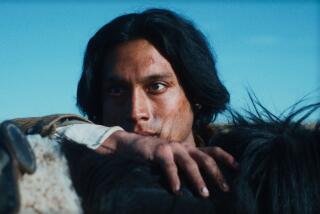Maya Con Dios : A FOREST OF KINGS; The Untold Story of the Ancient Maya <i> By Linda Schele and David Freidel (William Morrow: $29.95; 542 pp., illustrated) </i>
- Share via
“A Forest of Kings” takes over from “Blood of Kings,” the brilliant study by Linda Schele and Mary Ellen Miller that transformed our view of classical Mayan civilization as a peaceful kingdom held in thrall by time’s stately pageant across the millennia.
In this new, more accessible volume, archeologist Schele and David Freidel present fresh evidence, from decoded hieroglyphics to ceramic artifacts, that the Mayan king’s life was one of constant turmoil. When not engaged in wars of conquest to obtain captives for sacrifice, he intrigued to outmaneuver rival pretenders to the throne.
In their passion for immortality, the Mayan kings were closer in spirit to Egypt’s pharaohs than to the classical Greeks, a conceit favored by Sylvanus Morley and other Mayanists earlier in the century. The Mayan rulers sought personal immortality by erecting majestic monuments on whose stones they inscribed their grandest achievements. For the archeologists, as for the rest of us, the story of the Maya by and large is the records the victors left behind to glorify themselves.
The age of kings begins in Los Cerros, about 50 years before the dawn of Christianity. Schele and Freidel reenact for us the earliest kingship ceremonies carved in stone, the kings’ first self-mutilations to enter an altered or “trans-” state and invoke a “vision serpent” which opens the portal to the underworld.
More than any other event, the authors insist, more than the unending wars of conquest and the elaborate rights of accession and burial, the blood-letting ritual identified the Mayan king as a living god. As the membrane of the king’s genitals was perforated, he was seen as leaving the membrane of the human “middle world” to visit the “other world” of the immortals.
But this is also a story of bloody internecine wars and intramural rivalries. The king who vanquishes the “Lords of Death” in a blood-letting trans-state also remains a temporal ruler bent on expanding his empire by every means at his disposal. When they defeated a rival king, the Maya were cruel and unforgiving. They stripped vanquished rulers of their titles to exalt their own. They humiliated the losers as if they were common slaves, and slaughtered and entombed their warriors to accompany a deceased relative to the underworld.
How are we to reconcile the ruthless conqueror and court intriguer with the divinely invested shaman who sheds his life’s blood to bring darkness and light into balance and pollinate the Earth? This riddle is not resolved by the hieroglyphic record, and suggests the limitations of Schele’s and Freidel’s fusion of archeology and history.
How much of the Maya’s story can be told from decoding the extant hieroglyphic archive? Pioneer epigraphists such as Schele and Freidel deserve enormous credit for unlocking Mayan script without the benefit of a Rosetta stone; but only a fraction of the Mayan library is as yet available to us, and we will never know how many seminal manuscripts Friar Diego de Landa burned in the Plaza of Mani as “the work of the devil.”
Although the conquering kings could afford the luxury of propagating their feats in their monuments, the losers’ version of events remains in the dark. And we now know that rulers often altered dates and events to claim fictional victories. Like any system of writing since Sumerian cuneiform, hieroglyphics and codices could be traduced to enhance a Mayan king’s ill-gained reputation.
What does the extant hieroglyphic record tell us of the lives of the peasant farmer, the artisan or the stonemason, for that matter? Much of Schele’s and Freidel’s archeological sleuthing yields marvelous ore, and resonates with truth. But the more fanciful reconstructions and vignettes suffer from insufficient underpinning.
How do we know that captives sacrificed at Chichen Itza died a gentle death “because no one ever made a sound when his heart was cut out”? The battle scenes re-created here could be taken out of old film clips, they seem so stylized. It is as if thousands of isolated images lifted from stellae and ceramic bowls had been spliced together and projected on the page to create an illusion of continuity.
The authors’ insistence on blood-letting as the central act of the Mayan world seems open to question. Certainly, it was not an everyday event even among kings, nor does it appear to have been practiced commonly at all Mayan ceremonial centers. Our current theories may well be overhauled by future investigators.
The authors appear to be on solid ground in reconstructing the final days of kingship in Copan, all of whose forests had been felled, leading to environmental degradation and famine. “There were too many people, too much of the forest gone, too many nobles grabbing honor and power for their own benefit, too little faith in the old answers, too little rain, and too much death.” The forest around Copan did not recover until the last century, and, ominously, large-scale logging is under way once more.
But the authors have no explanation for why so many of the principal classical sites--Tikal, Palenque, Yaxchilan, Piedras Negras, Dos Pilas--were abandoned within a few years of one another, so precipitously that limestone stellae have been found partly hewn from their matrix.
In the past, every attempt to demystify the Maya has only served to deepen the mystery. Schele and Freidel may be correct in their claim to be the first to sound the depths of that story, and to legitimately call themselves historians of the Maya. And yet, relative to the huge gaps that remain to be filled, the lives of pharaohs 2,000 years earlier read like an open book.
More to Read
Sign up for Essential California
The most important California stories and recommendations in your inbox every morning.
You may occasionally receive promotional content from the Los Angeles Times.













